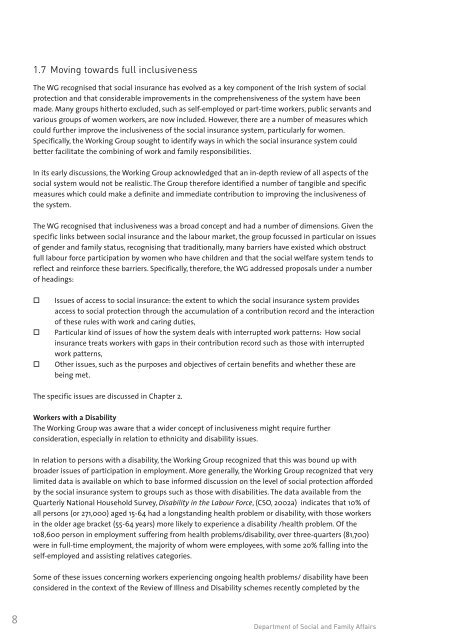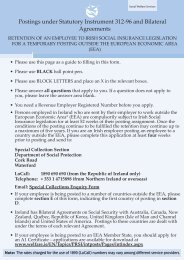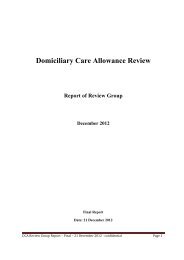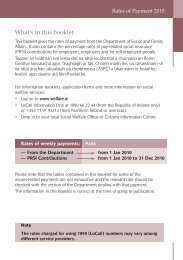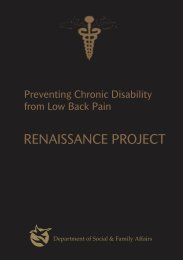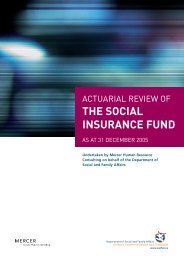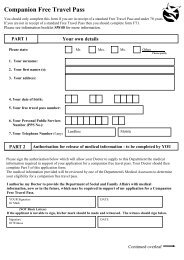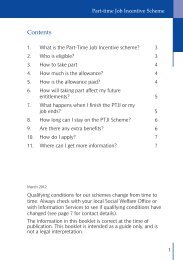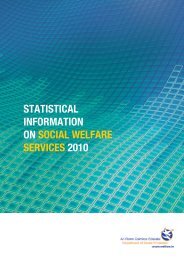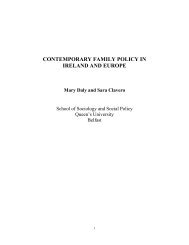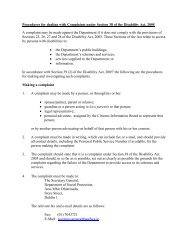Developing a Fully Inclusive Social Insurance Model - Welfare.ie
Developing a Fully Inclusive Social Insurance Model - Welfare.ie
Developing a Fully Inclusive Social Insurance Model - Welfare.ie
You also want an ePaper? Increase the reach of your titles
YUMPU automatically turns print PDFs into web optimized ePapers that Google loves.
1.7 Moving towards full inclusivenessThe WG recognised that social insurance has evolved as a key component of the Irish system of socialprotection and that considerable improvements in the comprehensiveness of the system have beenmade. Many groups hitherto excluded, such as self-employed or part-time workers, public servants andvarious groups of women workers, are now included. However, there are a number of measures whichcould further improve the inclusiveness of the social insurance system, particularly for women.Specifically, the Working Group sought to identify ways in which the social insurance system couldbetter facilitate the combining of work and family responsibilit<strong>ie</strong>s.In its early discussions, the Working Group acknowledged that an in-depth rev<strong>ie</strong>w of all aspects of thesocial system would not be realistic. The Group therefore identif<strong>ie</strong>d a number of tangible and specificmeasures which could make a definite and immediate contribution to improving the inclusiveness ofthe system.The WG recognised that inclusiveness was a broad concept and had a number of dimensions. Given thespecific links between social insurance and the labour market, the group focussed in particular on issuesof gender and family status, recognising that traditionally, many barr<strong>ie</strong>rs have existed which obstructfull labour force participation by women who have children and that the social welfare system tends toreflect and reinforce these barr<strong>ie</strong>rs. Specifically, therefore, the WG addressed proposals under a numberof headings:" Issues of access to social insurance: the extent to which the social insurance system providesaccess to social protection through the accumulation of a contribution record and the interactionof these rules with work and caring dut<strong>ie</strong>s," Particular kind of issues of how the system deals with interrupted work patterns: How socialinsurance treats workers with gaps in their contribution record such as those with interruptedwork patterns," Other issues, such as the purposes and objectives of certain benefits and whether these arebeing met.The specific issues are discussed in Chapter 2.Workers with a DisabilityThe Working Group was aware that a wider concept of inclusiveness might require furtherconsideration, especially in relation to ethnicity and disability issues.In relation to persons with a disability, the Working Group recognized that this was bound up withbroader issues of participation in employment. More generally, the Working Group recognized that verylimited data is available on which to base informed discussion on the level of social protection affordedby the social insurance system to groups such as those with disabilit<strong>ie</strong>s. The data available from theQuarterly National Household Survey, Disability in the Labour Force, (CSO, 2002a) indicates that 10% ofall persons (or 271,000) aged 15-64 had a longstanding health problem or disability, with those workersin the older age bracket (55-64 years) more likely to exper<strong>ie</strong>nce a disability /health problem. Of the108,600 person in employment suffering from health problems/disability, over three-quarters (81,700)were in full-time employment, the majority of whom were employees, with some 20% falling into theself-employed and assisting relatives categor<strong>ie</strong>s.Some of these issues concerning workers exper<strong>ie</strong>ncing ongoing health problems/ disability have beenconsidered in the context of the Rev<strong>ie</strong>w of Illness and Disability schemes recently completed by the8Department of <strong>Social</strong> and Family Affairs


